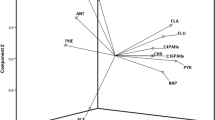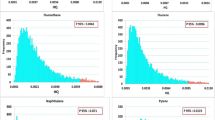Abstract
Smoked meat is widely consumed in many areas, particularly in rural southwest China. High concentrations of polycyclic aromatic hydrocarbons (PAHs) in smoked meat could lead to adverse dietary exposure and health risks. In this study, 27 parent PAHs (pPAHs), 12 nitrated PAHs (nPAHs), and 4 oxygenated PAHs (oPAHs) were measured in coal- and wood-smoked meats. The median concentrations of pPAHs, nPAHs, and oPAHs were as high as 1.66 × 103, 4.29, and 20.5 ng/g in the coal-smoked meat and 2.54 × 103, 7.32, and 9.26 ng/g in the wood-smoked meat, respectively. Based on the relative potency factors of individual PAHs, the calculated toxic equivalent (TEQ) values of all pPAHs were 22.1 and 75.1 ng TEQ/g for the wood- and coal-smoked meats, respectively. The highest concentrations of PAHs can be found in the surface layer of skin and decrease exponentially with depth. Surface PAH concentrations correlated with concentrations of PAHs in household air and with the concentration in emission exhaust. Migration of PAHs from surface to interior portions of meat is faster in lean than in fat or skin, and oPAHs and pPAHs can penetrate deeper than pPAHs. The penetration ability of PAHs is negatively correlated with the molecular weight.






Similar content being viewed by others
References
Bird RG, Stewart WE, Lightfoot EN (2007) Transport phenomena. Wiley Press, New York
Bostrom CE, Gerde P, Hanberg A, Jernstrom B, Johansson C, Kyrklund T, Rannug A, Tornqvist M, Victorin K, Westerholm R (2002) Cancer risk assessment, indicators, and guidelines for polycyclic aromatic hydrocarbons in the ambient air. Environ Health Perspect 110:451–488
Collins JF, Brown JP, Alexeeff GV, Salmon AG (1998) Potency equivalency factors for some polycyclic aromatic hydrocarbons and polycyclic aromatic hydrocarbon derivatives. Regul Toxicol Pharmacol 28:45–54
Ding JN, Zhong JJ, Yang YF, Li BG, Shen GF, Su YH, Wang C, Li W, Shen HZ, Wang B, Wang R, Huang Y, Zhang YY, Cao HY, Ying Z, Simonich SM, Tao S (2012) Occurrence and exposure to polycyclic aromatic hydrocarbons and their derivatives in a rural Chinese home through biomass fuelled cooking. Environ Pollut 169:160–166
Durant JL, Busby WF, Lafleur AL, Penman BW, Crespi CL (1996) Human cell mutagenicity of oxygenated, nitrated and unsubstituted polycyclic aromatic hydrocarbons associated with urban aerosols. Mutat Res Genet Toxicol Environ 371:123–157
Galarneau E (2008) Source specificity and atmospheric processing of airborne PAHs: implications for source apportionment. Atmos Environ 42:8139–8149
General Administration of Quality Supervision (2012) Inspection and quarantine of P.R.C. Ministry of Health of P.R.C Bureau of Environmental Protection of P.R.C.; Indoor air quality standard of P.R.C. GB 3095-2012, Beijing
Gomaa EA, Gray JI, Rabie S, Lopez-Bote C, Booren AM (1993) Polycyclic aromatic hydrocarbons in smoked food products and commercial liquid smoke flavourings. Food Addit Contam 10:503–521
Larsen JC, Larsen PB (1998) Chemical carcinogens. In: Hester RE, Harrison RM (eds) Air pollution and health. The Royal Society of Chemistry, Cambridge, pp 33–56
Layshock J, Simonich SM, Anderson KA (2010) Effect of dibenzopyrene measurement on assessing air quality in Beijing air and possible implications for human health. J Environ Monitor 12:2290–2298
Li YX, Zhang H, Mao LS, Sun CJ (2003) Determination of polycyclic aromatic hydrocarbons in smoked meat by gas chromatography/mass spectrometry. Chin J Chromatogr 21:476–479 (in Chinese)
Lorenzo JM, Purriños L, Fontán MCG, Franco D (2010) Polycyclic aromatic hydrocarbons (PAHs) in two Spanish traditional smoked sausage varieties: “Androlla” and “Botillo”. Meat Sci 86:660–664
Malcolm HM, Dobson S (1994) The calculation of the environmental assessment level (EAL) for atmospheric PAHs using relative potencies. Her Majesty’s Inspectorate of Pollution, Great Britain
Muller J (1997) Occurrence and distribution processes of semivolatile organic chemicals in the atmosphere and leaves. Griffith University, Australia
Nisbet ICT, LaGoy PK (1992) Toxic equivalency factors (TEFs) for polycyclic aromatic hydrocarbons (PAHs). Regul Toxicol Pharmacol 16:290–300
Petry T, Schmid P, Schlatter C (1996) The use of toxic equivalency factors in assessing occupational and environmental health risk associated with exposure to airborne mixtures of polycyclic aromatic hydrocarbons (PAHs). Chemosphere 32:639–648
Phillips D (1999) Polycyclic aromatic hydrocarbons in the diet. Mutat Res Genet Toxicol Environ 443:139–147
Ramdahl T (1983) Retene-a molecular marker of wood combustion in ambient air. Nature 580–582
Shen GF, Wang W, Yang YF, Zhu C, Min YJ, Xue M, Ding JN, Li W, Wang B, Shen HZ, Wang R, Wang XL, Tao S (2010) Emission factors and particulate matter size distribution of polycyclic aromatic hydrocarbons from residential coal combustions in rural Northern China. Atmos Environ 44:5237–5243
Shen GF, Tao S, Wang W, Yang YF, Ding JN, Xue M, Min YJ, Zhu C, Shen HZ, Li W, Wang B, Wang R, Wang WT, Wang XL, Russell AG (2011) Emission of oxygenated polycyclic aromatic hydrocarbons from indoor solid fuel combustion. Environ Sci Technol 45:3459–3465
Shen GF, Wei SY, Zhang YY, Wang R, Wang B, Li W, Shen HZ, Huang Y, Chen YC, Chen H, Wei W, Tao S (2012a) Emission of oxygenated polycyclic aromatic hydrocarbons from biomass pellet burning in a modern burner for cooking in China. Atmos Environ 60:234–237
Shen GF, Tao S, Wei SY, Zhang YY, Wang R, Wang B, Li W, Shen HZ, Huang Y, Yang YF, Wang W, Wang XL, Simonich SM (2012b) Retene emission from residential solid fuels in China and evaluation of retene as a unique marker for soft wood combustion. Environ Sci Technol 46:4666–4672
Shen HZ, Huang Y, Wang R, Zhu D, Li W, Shen GF, Wang B, Zhang YY, Chen YC, Lu Y, Chen H, Li TC, Sun K, Li BG, Liu WX, Liu JF, Tao S (2013a) Global atmospheric emissions of polycyclic aromatic hydrocarbons from 1960 to 2008 and future predictions. Environ Sci Technol 47:6415–6424
Shen GF, Tao S, Chen YC, Zhang YY, Wei SY, Xue M, Wang B, Wang R, Lu Y, Li W, Shen HZ, Huang Y, Chen H (2013b) Emission characteristics for polycyclic aromatic hydrocarbons from solid fuels burned in domestic stoves in rural China. Environ Sci Technol 47:14485–14494
Simko P, Knezo J (1992) Influence of cooking on benzo(a)pyrene content in frankfurters. Nahrung/Food 36:208–209
USEPA (2012) Development of a relative potency factor (RPF) approach for polycyclic aromatic hydrocarbon (PAH) mixtures. Integrated Risk Information System (IRIS), Washington
Xia ZH, Duan XL, Qiu WX, Liu D, Wang B, Tao S, Jiang QJ, Lu B, Song YX, Xu XX (2010) Health risk assessment on dietary exposure to polycyclic aromatic hydrocarbons (PAHs) in Taiyuan, China. Sci Total Environ 408:5331–5337
Yoon E, Park K, Lee H, Yang JH, Lee C (2007) Estimation of excess cancer risk on time-weighted lifetime average daily intake of PAHs from food ingestion. Hum Ecol Risk Assess 13:669–680
Zhang YH, Tao S, Shen HZ, Ma JM (2009) Inhalation exposure to ambient polycyclic aromatic hydrocarbons and lung cancer risk of Chinese population. Proc Natl Acad Sci 106:21063–21067
Zhang YY, Ding JN, Sheng GF, Zhong JJ, Wang C, Wei SY, Chen CQ, Chen YC, Lu Y, Shen HZ, Li W, Huang Y, Chen H, Su S, Lin N, Wang XL, Liu WX, Tao S (2014) Dietary and inhalation exposure to polycyclic aromatic hydrocarbons and urinary excretion of monohydroxy metabolites—a controlled case study in Beijing, China. Environ Pollut 184:515–522
Acknowledgments
This work was supported by the National Science Foundation of China (Grant No. 41390240, 41130754, and 41390243). The authors thank anonymous reviewers and Raymond Coveney from UMKC for the valuable suggestions and for polishing the manuscript.
Conflict of interest
The authors declare no completing financial interest.
Author information
Authors and Affiliations
Corresponding author
Additional information
Responsible editor: Ester Heath
Highlights
• High concentrations of PAHs were observed in the coal- and wood-smoked meat.
• PAHs in the coal and smoked meat are derived from the combustion of fuels and air-borne PAHs.
• It is easier for PAHs to transfer in lean than in fat.
• Low molecular weight PAHs can penetrate deeper than high molecular weight PAHs in smoked meat.
Electronic supplementary material
Supporting materials associated with this article are provided and available free of charge via the Internet.
ESM 1
(DOC 801 kb)
Rights and permissions
About this article
Cite this article
Chen, Y., Shen, G., Su, S. et al. Contamination and distribution of parent, nitrated, and oxygenated polycyclic aromatic hydrocarbons in smoked meat. Environ Sci Pollut Res 21, 11521–11530 (2014). https://doi.org/10.1007/s11356-014-3129-8
Received:
Accepted:
Published:
Issue Date:
DOI: https://doi.org/10.1007/s11356-014-3129-8




